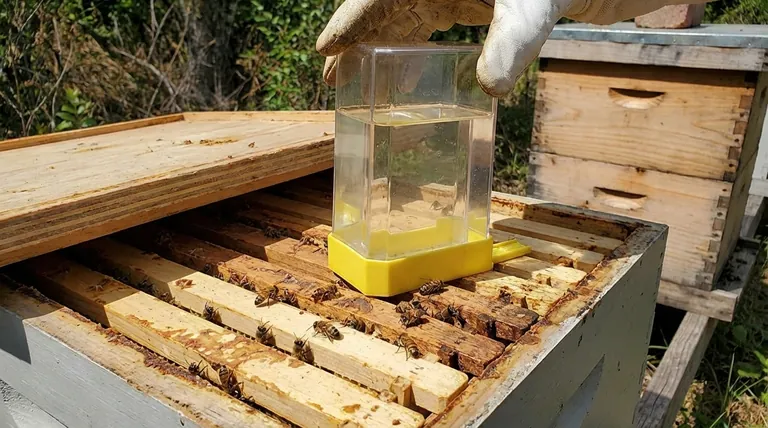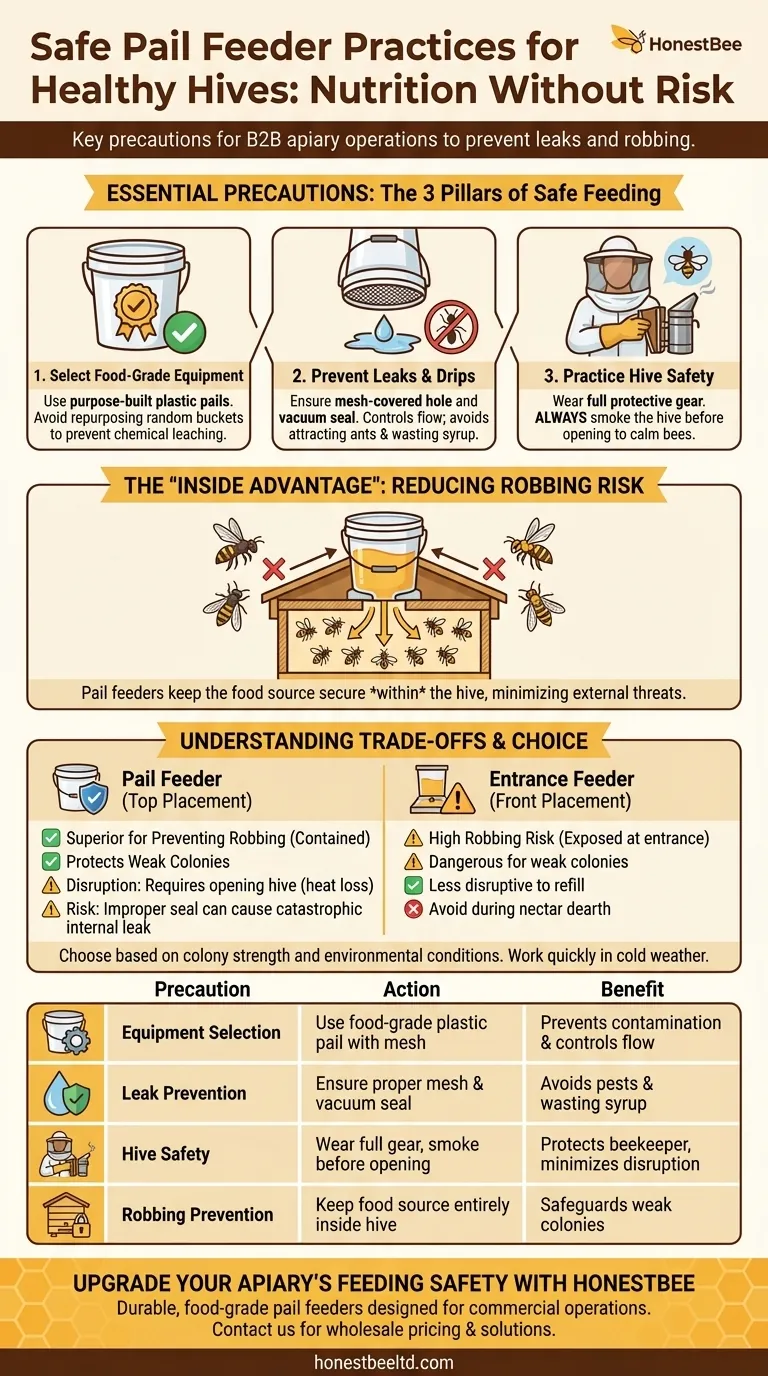When using a pail feeder, your primary precautions involve selecting the right equipment to prevent leaks and taking standard safety measures when opening the hive. Use a food-grade plastic pail designed specifically for beekeeping, ensure it has a mesh-covered hole to control dripping, and always wear full protective gear after smoking the hive to calm the bees.
The core challenge of feeding bees is providing nutrition without introducing new risks like pest infestations or robbing from other colonies. A properly used pail feeder minimizes these risks by containing the syrup securely within the hive, making it one of the safest methods available.

The Principles of Safe and Effective Bee Feeding
The goal of supplemental feeding is to support a colony, not to create new problems. Every time you offer food, you must consider the potential vulnerabilities you are introducing.
Your Goal: Nutrition Without Risk
Feeding is a powerful tool, especially for new or weak colonies, or during a nectar dearth. However, the presence of sugar syrup can attract unwanted attention from pests like ants or trigger "robbing," where stronger neighboring hives attack to steal the food source.
Why Pail Feeders Are a Common Solution
A pail feeder is a type of top feeder. It is essentially a bucket with a small, screened hole in the lid, which is inverted over the hole in the hive's inner cover. This design keeps the food source entirely inside the hive's protected space, drastically reducing the risk of attracting outsiders.
Essential Precautions for Pail Feeder Use
Proper use comes down to three key areas: the equipment itself, the prevention of leaks, and your personal safety protocols when accessing the hive.
Choose the Right Equipment
Your feeder must be made of food-grade plastic. This ensures no harmful chemicals will leach into the sugar syrup and subsequently into your colony. Avoid repurposing random plastic buckets.
Prevent Leaks and Drips
The feeder's hole must have a mesh covering. This mesh, combined with the vacuum created inside the pail, regulates the flow of syrup. Without it, syrup can drip excessively or even pour into the hive.
Excess dripping wastes expensive syrup and, more importantly, attracts ants. A trail of sweet-smelling syrup leading to your hive is an open invitation for a pest invasion.
Practice Hive Safety
Always wear full protective gear, including a veil, gloves, and a bee suit or jacket. Even a quick check on the feeder level requires opening the hive.
Gently smoke the hive before opening it. This helps mask alarm pheromones and encourages the bees to be calmer, making the process of refilling the feeder safer for you and less disruptive for them.
Understanding the Trade-offs: Pail vs. Other Feeders
No feeding method is perfect. Understanding the pros and cons of pail feeders compared to other types helps you make an informed decision.
Pail Feeders vs. Entrance Feeders
Pail feeders are far superior for preventing robbing. Entrance feeders place the food source at the front door of the hive, advertising its presence to every bee, wasp, and hornet in the area. This is extremely dangerous for weaker colonies.
Entrance feeders should only be used with extreme caution, and never during a nectar dearth when robbing pressure is at its highest. Pail feeders, by keeping the food contained, are a much safer default choice.
Potential Downsides of Pail Feeders
Refilling a pail feeder requires you to open the hive lid. This breaks the propolis seal and can be disruptive, especially in cold weather when it allows heat to escape from the brood nest.
Furthermore, an improper seal or a cracked pail can cause a catastrophic leak inside the hive. This can drown bees and create a massive, unhealthy mess that the colony must clean up.
Making the Right Choice for Your Colony
Your choice of feeder should always be based on your colony's strength and the current environmental conditions.
- If your primary focus is preventing robbing: A pail feeder is one of the best choices because it contains the food source entirely within the hive.
- If your primary focus is feeding a weak colony: A pail feeder is a safe option that protects the vulnerable hive from outside threats during feeding.
- If your primary focus is feeding in cold weather: Be mindful that opening the hive to refill a pail feeder can chill the brood; work quickly and efficiently.
By understanding how your feeder choice impacts hive security, you can provide the nutrition your bees need to thrive.
Summary Table:
| Precaution | Key Action | Benefit |
|---|---|---|
| Equipment Selection | Use food-grade plastic pail with mesh-covered hole | Prevents chemical contamination and controls syrup flow |
| Leak Prevention | Ensure proper mesh screen and vacuum seal | Avoids attracting pests and wasting syrup |
| Hive Safety | Wear full protective gear and smoke hive before opening | Protects beekeeper and minimizes colony disruption |
| Robbing Prevention | Keep food source entirely inside hive | Safeguards weak colonies from external threats |
Upgrade Your Apiary's Feeding Safety with HONESTBEE
Ensure your colonies receive nutrition without risks. HONESTBEE supplies commercial apiaries and beekeeping equipment distributors with durable, food-grade pail feeders designed to prevent leaks and robbing. Our wholesale-focused operations provide reliable equipment that protects your investment and supports hive health.
Contact HONESTBEE today to discuss bulk pricing and find the right feeding solutions for your operation.
Visual Guide

Related Products
- Professional Hive Front Entrance Bee Feeder
- Boardman Entrance Bee Feeder Durable Galvanized Steel and Wood Construction for Beekeeping
- HONESTBEE Entrance Bee Feeder Professional Hive Nutrition Solution for Beekeeping
- Classic Boardman Entrance Bee Feeder Hive Front Feeding Solution
- Professional Hive Top Bee Feeder for Beekeeping
People Also Ask
- How does a beehive entrance feeder work? A Simple Guide to Supplemental Feeding
- Are entrance feeders good for bees? Prioritize Hive Health Over Convenience
- What is an entrance feeder and how is it used? Avoid the Critical Risk of Robbing
- How do you make an entrance feeder for bees? A Guide to Safe & Effective Hive Feeding
- How does an entrance feeder work? A Guide to Its Simple Mechanics and Risks



















